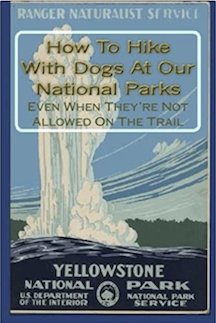Using a broad brush hiking in South Dakota can be broken into three buckets. Eastern South Dakota is marked by loess (pronounced LUSS) hills that were silt deposits along the eastern edge of the Missouri River Valley that strong prairie winds have blown into hills at least 60 feet high. In the center of the state are parks clustered along the Missouri River and in the southwest are the Black Hills, a small, isolated mountain range so thick with pine trees they appeared black to early explorers. No trails in the east and central regions of the state are ever likely to end up on picture postcards or lists of best hikes. They are, however, mostly all tail-friendly and the lakes and prairies and woodlands will delight any dog. The Black Hills, on the other hand, are a world class hiking destination. Custer State Park here is the largest state park in the continental United States and home to one America’'s largest free-ranging buffalo herds. Sylvan Lake is a calendar-worthy pool of water flanked by giant granite boulders and after a swim your dog can climb Trail #9 to the summit of Black Elk Peak, the highest spot east of the Rocky Mountains. Toss in Spearfish Canyon and Flume Trail #50 in the Black Hills National Forest and the Fort Meade Recreation Area and the canine hiking hits just keep coming. But dogs are also not allowed on the trails in Badlands National Park or Wind Cave National Park or Jewel Cave National Park. Dogs can only see Mount Rushmore from a distance and never make it to Bear Butte. That’s a few too many, “Yes, buts” for our tastes.
The Best Day Hike You Can Take With Your Dog In South Dakota
Trail 9: Black Elk Peak Trail
Custer State Park • Custer
General George Armstrong Custer headed an expedition into the Black Hills in 1874, then considered one of the last unexplored regions of the United States. Custer and his men discovered gold and the region was a secret no more. Precious metals are just part of the cornucopia of riches found in the Black Hills. Custer State Park, the largest state park in the continental United States, supports its 73,000 acres without government money.
One of the best places to begin exploring this vast outdoor playground with Seaman are the trails around Sylvan Lake, a calendar cover-worthy pool of water flanked by giant granite boulders that formed when Theodore Reder dammed Sunday Gulch in 1921. A pleasant one-mile loop circumnavigates the lake and offers plenty of dog-paddling along the way.
Sylvan Lake is also a popular jumping off point to climb Black Elk Peak, at 7,242 feet the highest point in America east of the Rocky Mountains. The most traveled route to the summit is on Trail 9, an 8-mile round trip through Ponderosa pines, spruce, and aspen. There is some rock scrambling near the top but Seaman can make it all the way and even go up the steps into the abandoned stone fire tower. Native stone was hauled to the summit for construction during the mid-1930s. Views from the craggy open summit - the mountain has over 2,900 feet of prominence - reach into four states, including the world’s largest buffalo herds that graze in the park.
HIKING TIME: 3-4 hours
(from the book 300 Day Hikes To Take With Your Dog Before He Tires You Out: Trails where you won’t be able to wipe the wag off your dog’s tail)
National Parks with Hiking
Badlands National Park
Dogs are prohibited from hiking trails and back- country areas, including the Badlands Wilderness Area. Dogs can stay in the campgrounds and hike anywhere that is open to motor vehicles.
Jewel Cave National Monument
No dogs on the trails, service roads or in the cave.
Wind Cave National Park
Dogs are not allowed in the cave or on most the trails at Wind Cave National Park; dogs can go on two short nature trails, at the campground and at the visitor center.
Links to National Forests With Hiking
Black Hills National Forest
Buffalo Gap National Grassland
Fort Pierre National Grassland
Grand River National Grassland
State Parks With Hiking
South Dakota State Parks
Dogs are welcome in South Dakota state parks on a leash less than 10 feet long.
All dogs are prohibited within the posted area at zoned swimming beaches.
Adams Homestead and Nature Preserve
Bear Butte State Park
Big Sioux Recreation Area
Burke Lake Recreation Area
Custer State Park
Farm Island Recreation Area
Fisher Grove State Park
George S. Mickelson Trail
Hartford Beach State Park
Lake Herman State Park
Lake Hiddenwood Recreation Area
Lake Louise Recreation Area
Lake Poinsett Recreation Area
Lake Thompson Recreation Area
Lake Vermillion Recreation Area
Lewis and Clark Recreation Area
Mina Lake Recreation Area
Newton Hills State Park
Oakwood Lake State Park
Palisades State Park
Pelican Lake Recreation Area
Pickerel Lake Recreation Area
Pierson Ranch Recreation Area
Platte Creek Recreation Area
Richmond Lake Recreation Area
Roy Lake State Park
Sica Hollow State Park
Snake Creek Recreation Area
Union County State Park
West Whitlock Recreation Area


